Related Research Articles

A laser is a device that emits light through a process of optical amplification based on the stimulated emission of electromagnetic radiation. The word "laser" is an acronym for "light amplification by stimulated emission of radiation". The first laser was built in 1960 by Theodore H. Maiman at Hughes Research Laboratories, based on theoretical work by Charles Hard Townes and Arthur Leonard Schawlow.
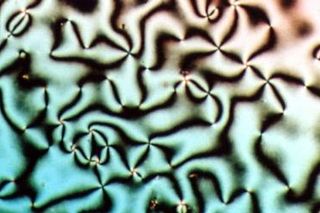
Liquid crystal (LC) is a state of matter whose properties are between those of conventional liquids and those of solid crystals. For example, a liquid crystal may flow like a liquid, but its molecules may be oriented in a crystal-like way. There are many types of LC phases, which can be distinguished by their optical properties. The contrasting textures arise due to molecules within one area of material ("domain") being oriented in the same direction but different areas having different orientations. LC materials may not always be in a LC state of matter.

A dye laser is a laser that uses an organic dye as the lasing medium, usually as a liquid solution. Compared to gases and most solid state lasing media, a dye can usually be used for a much wider range of wavelengths, often spanning 50 to 100 nanometers or more. The wide bandwidth makes them particularly suitable for tunable lasers and pulsed lasers. The dye rhodamine 6G, for example, can be tuned from 635 nm (orangish-red) to 560 nm (greenish-yellow), and produce pulses as short as 16 femtoseconds. Moreover, the dye can be replaced by another type in order to generate an even broader range of wavelengths with the same laser, from the near-infrared to the near-ultraviolet, although this usually requires replacing other optical components in the laser as well, such as dielectric mirrors or pump lasers.
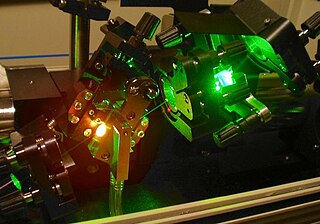
Ti:sapphire lasers (also known as Ti:Al2O3 lasers, titanium-sapphire lasers, or Ti:sapphs) are tunable lasers which emit red and near-infrared light in the range from 650 to 1100 nanometers. These lasers are mainly used in scientific research because of their tunability and their ability to generate ultrashort pulses. Lasers based on Ti:sapphire were first constructed and invented in June 1982 by Peter Moulton at the MIT Lincoln Laboratory.
A Raman laser is a specific type of laser in which the fundamental light-amplification mechanism is stimulated Raman scattering. In contrast, most "conventional" lasers rely on stimulated electronic transitions to amplify light.

A solid-state laser is a laser that uses a gain medium that is a solid, rather than a liquid as in dye lasers or a gas as in gas lasers. Semiconductor-based lasers are also in the solid state, but are generally considered as a separate class from solid-state lasers, called laser diodes.
Amplified spontaneous emission (ASE) or superluminescence is light, produced by spontaneous emission, that has been optically amplified by the process of stimulated emission in a gain medium. It is inherent in the field of random lasers.
A fiber laser is a laser in which the active gain medium is an optical fiber doped with rare-earth elements such as erbium, ytterbium, neodymium, dysprosium, praseodymium, thulium and holmium. They are related to doped fiber amplifiers, which provide light amplification without lasing. Fiber nonlinearities, such as stimulated Raman scattering or four-wave mixing can also provide gain and thus serve as gain media for a fiber laser.
Optical axis gratings (OAGs) are gratings of optical axis of a birefringent material. In OAGs, the birefringence of the material is constant, while the direction of optical axis is periodically modulated in a fixed direction. In this way they are different from the regular phase gratings, in which the refractive index is modulated and the direction of the optical axis is constant.
Power scaling of a laser is increasing its output power without changing the geometry, shape, or principle of operation. Power scalability is considered an important advantage in a laser design.
Chiral Photonics, Inc. is a photonics company based in Pine Brook, New Jersey, founded in 1999. The company is developing a new class of optical devices based on twisting glass optical fibers. These in-fiber devices aim to displace discrete optical elements such as lasers, filters and sensors. They benefit from optical fiber’s transmission efficiency, robustness and ease of integration.
A blue phase mode LCD is a liquid crystal display (LCD) technology that uses highly twisted cholesteric phases in a blue phase. It was first proposed in 2007 to obtain a better display of moving images with, for example, frame rates of 100–120 Hz to improve the temporal response of LCDs. This operational mode for LCDs also does not require anisotropic alignment layers and thus theoretically simplifies the LCD manufacturing process.
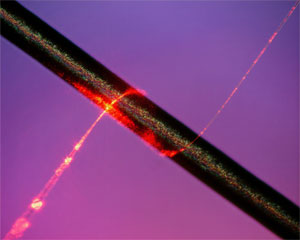
A subwavelength-diameter optical fibre is an optical fibre whose diameter is less than the wavelength of the light being propagated through it. An SDF usually consists of long thick parts at both ends, transition regions (tapers) where the fibre diameter gradually decreases down to the subwavelength value, and a subwavelength-diameter waist, which is the main acting part. Due to such a strong geometrical confinement, the guided electromagnetic field in an SDF is restricted to a single mode called fundamental.

In optics, a nematicon is a spatial soliton in nematic liquid crystals (NLC). The name was invented in 2003 by G. Assanto. and used thereafter Nematicons are generated by a special type of optical nonlinearity present in NLC: the light induced reorientation of the molecular director. This nonlinearity arises from the fact that the molecular director tends to align along the electric field of light. Nematicons are easy to generate because the NLC dielectric medium exhibits the following properties:
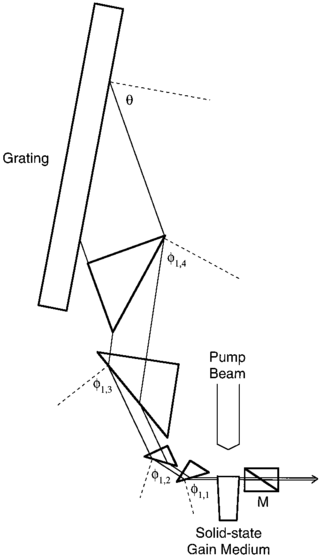
Solid-state dye lasers (SSDL) were introduced in 1967 by Soffer and McFarland. In these solid-state lasers, the gain medium is a laser dye-doped organic matrix such as poly(methyl methacrylate) (PMMA), rather than a liquid solution of the dye. An example is rhodamine 6G-doped PMMA. These lasers are also referred to as solid-state organic lasers and solid-state dye-doped polymer lasers.

Organic lasers use an organic material as the gain medium. The first organic laser was the liquid dye laser. These lasers use laser dye solutions as their gain media.

Organic photonics includes the generation, emission, transmission, modulation, signal processing, switching, amplification, and detection/sensing of light, using organic optical materials.
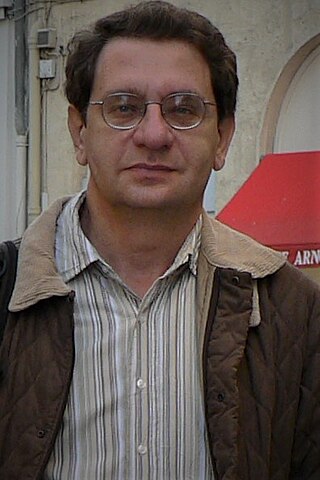
Yuriy Reznikov was a Ukrainian physicist, Head of the Department of Crystals at NASU Institute of Physics and a world-renown expert in the field of liquid crystals. He is known for his work on photoalignment, "giant" optical non-linearity of liquid crystals and nano-colloids.

A Pr:YLF laser (or Pr3+:LiYF4 laser) is a solid state laser that uses a praseodymium doped yttrium-lithium-fluoride crystal as its gain medium. The first Pr:YLF laser was built in 1977 and emitted pulses at 479 nm. Pr:YLF lasers can emit in many different wavelengths in the visible spectrum of light, making them potentially interesting for RGB applications and materials processing. Notable emission wavelengths are 479 nm, 523 nm, 607 nm and 640 nm.
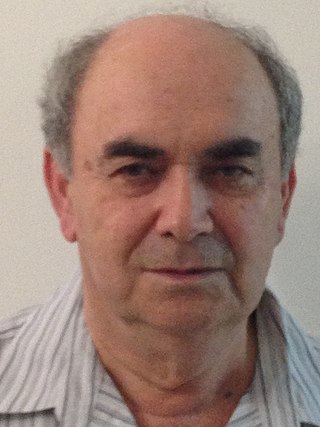
Baruch Fischer is an Israeli optical physicist and Professor Emeritus in the Andrew and Erna Viterbi Faculty of Electrical and Computer Engineering of the Technion, where he was the Max Knoll Chair in Electro-Optics and Electronics.
References
- 1 2 Woltman 2007, p. 357
- ↑ Jacobs; Cerqua; Marshall; Schmid; Guardalben; Skerrett (1988). "Liquid-crystal laser optics: design, fabrication, and performance". Journal of the Optical Society of America B. 5 (9): 1962. Bibcode:1988JOSAB...5.1962J. doi:10.1364/JOSAB.5.001962.
- ↑ Kogelnik, H.; C.V. Shank (1971). "Stimulated emission in a periodic structure". Applied Physics Letters. 18 (4): 152. Bibcode:1971ApPhL..18..152K. doi:10.1063/1.1653605.
- ↑ Kukhtarev, NV (1978). "Cholesteric liquid crystal laser with distributed feedback". Soviet Journal of Quantum Electronics. 8 (6): 774–776. Bibcode:1978QuEle...8..774K. doi:10.1070/QE1978v008n06ABEH010397.
- 1 2 Ilchishin, I.P.; E.A. Tikhonov; V.G. Tishchenko; M.T. Shpak (1980). "Generation of a tunable radiation by impurity cholesteric liquid crystals". Journal of Experimental and Theoretical Physics Letters. 32: 24–27. Bibcode:1980JETPL..32...24I.
- ↑ Woltman 2007, p. 310
- 1 2 Kopp, V.I.; B. Fan; H. K. M. Vithana; A. Z. Genack (1998). "Low-threshold lasing at the edge of a photonic stop band in cholesteric liquid crystals". Optics Express. 23 (21): 1707–1709. Bibcode:1998OptL...23.1707K. doi:10.1364/OL.23.001707. PMID 18091891. S2CID 17966093.
- 1 2 Dolgaleva, Ksenia; Simon K.H. Wei; Svetlana G. Lukishova; Shaw H. Chen; Katie Schwertz; Robert W. Boyd (2008). "Enhanced laser performance of cholesteric liquid crystals doped with oligofluorene dye". Journal of the Optical Society of America. 25 (9): 1496–1504. Bibcode:2008JOSAB..25.1496D. doi:10.1364/JOSAB.25.001496.
- ↑ Lawrence Goldberg and Joel Schnur Tunable internal-feedback liquid crystal-dye laser U.S. Patent 3,771,065 Issue date: 1973
- ↑ Kuroda, Keiji; Tsutomu Sawada; Takashi Kuroda; Kenji Watanabe; Kazuaki Sakoda (2009). "Doubly enhanced spontaneous emission due to increased photon density of states at photonic band edge frequencies". Optics Express. 17 (15): 13168–13177. Bibcode:2009OExpr..1713168K. doi: 10.1364/OE.17.013168 . PMID 19654722.
- 1 2 Yablonovich, Eli (1987). "Inhibited Spontaneous Emission in Solid-State Physics and Electronics". Physical Review Letters. 58 (20): 2059–2062. Bibcode:1987PhRvL..58.2059Y. doi: 10.1103/PhysRevLett.58.2059 . PMID 10034639.
- ↑ Lucchetti, L.; M. Di Fabrizio; O. Francescangeli; F. Simoni (2004). "Colossal optical nonlinearity in dye doped liquid crystals". Optics Communications. 233 (4–6): 417–424. Bibcode:2004OptCo.233..417L. doi:10.1016/j.optcom.2004.01.057.
- ↑ Khoo, I.C. (1995). "Holographic grating formation in dye- and fullerene C60-doped nematic liquid-crystal film". Optics Letters. 20 (20): 2137–2139. Bibcode:1995OptL...20.2137K. doi:10.1364/OL.20.002137. PMID 19862276.
- ↑ Khoo, Iam-Choo (2007). Liquid Crystals. Wiley-Interscience. ISBN 978-0-471-75153-3.
- 1 2 Morris, Stephen M.; Philip JW Hands; Sonja Findeisen-Tandel; Robert H. Cole; Timothy D. Wilkinson; Harry J. Coles (2008). "Polychromatic liquid crystal laser arrays towards display applications" (PDF). Optics Express. 16 (23): 18827–37. Bibcode:2008OExpr..1618827M. doi: 10.1364/OE.16.018827 . PMID 19581971.
- ↑ Maune, Brett; Marko Lončar; Jeremy Witzens; Michael Hochberg; Thomas Baehr-Jones; Demetri Psaltis; Axel Scherer; Yueming Qiu (2004). "Liquid-crystal electric tuning of a photonic crystal laser" (PDF). Applied Physics Letters. 85 (3): 360. Bibcode:2004ApPhL..85..360M. doi:10.1063/1.1772869.
- ↑ Furumi, Seiichi; Shiyoshi Yokoyama; Akira Otomo; Shinro Mashiko (2004). "Phototunable photonic bandgap in chiral liquid crystal device". Applied Physics Letters. 84 (14): 2491. Bibcode:2004ApPhL..84.2491F. doi:10.1063/1.1699445.
- ↑ Andy, Fuh; Tsung-Hsien Lin; J.-H. Liu; F.-C. Wu (2004). "Lasing in chiral photonic liquid crystals and associated frequency tuning". Optics Express. 12 (9): 1857–1863. Bibcode:2004OExpr..12.1857F. doi: 10.1364/OPEX.12.001857 . PMID 19475016.
- ↑ Khoo, Iam-Choo; Wu, Shin-Tson (1993). Optics and nonlinear optics of liquid crystals. World Scientific. ISBN 978-981-02-0934-6.
- ↑ Morris, S.M.; A. D. Ford; M. N. Pivnenko; H. J. Coles (2005). "Enhanced emission from liquid-crystal lasers". Journal of Applied Physics. 97 (2): 023103–023103–9. Bibcode:2005JAP....97b3103M. doi:10.1063/1.1829144.
- ↑ Morris, SM; AD Ford; HJ Coles (July 2009). "Removing the discontinuous shifts in emission wavelength of a chiral nematic liquid crystal laser". Journal of Applied Physics. 106 (2): 023112–023112–4. Bibcode:2009JAP...106b3112M. doi:10.1063/1.3177251.
- ↑ Ozaki, M.; M. Kasano; D. Ganzke; W. Haase; K. Yoshino (2002). "Mirrorless lasing in a dye-doped ferroelectric liquid crystal". Advanced Materials. 14 (4): 306–309. doi:10.1002/1521-4095(20020219)14:4<306::AID-ADMA306>3.0.CO;2-1.
- ↑ Huang, Yuhua; Ying Zhou; Shin-Tson Wu (2006). "Spatially tunable laser emission in dye-doped photonic liquid crystals". Applied Physics Letters. 88 (1): 011107. Bibcode:2006ApPhL..88a1107H. doi:10.1063/1.2161167. S2CID 119500768.
- ↑ Jeong, Mi-Yun; Hyunhee Choi; J. W. Wu (2008). "Spatial tuning of laser emission in a dye-doped cholesteric liquid crystal wedge cell". Applied Physics Letters. 92 (5): 051108. Bibcode:2008ApPhL..92e1108J. doi:10.1063/1.2841820.
- ↑ Woltman 2007, pp. 332–334
- ↑ Schmidtke, Jürgen; Werner Stille; Heino Finkelmann (2003). "Defect Mode Emission of a Dye Doped Cholesteric Polymer Network" (PDF). Physical Review Letters. 90 (8): 083902. Bibcode:2003PhRvL..90h3902S. doi:10.1103/PhysRevLett.90.083902. PMID 12633428 . Retrieved 2011-04-29.
- ↑ Lee, C.-R.; Lin, S.-H.; Yeh, H.-C.; Ji, T.-D. (7 December 2009). "Band-tunable color cone lasing emission based on dye-doped cholesteric liquid crystals with various pitches and a pitch gradient" (PDF). Optics Express. 17 (25): 22616–23. Bibcode:2009OExpr..1722616L. doi: 10.1364/oe.17.022616 . PMID 20052187.
- 1 2 "Liquid crystal lasers the size of a human hair". Physorg. December 2005. Retrieved 2011-04-09.
- ↑ "Liquid crystal lasers promise cheaper, high colour resolution laser television". Physorg. April 2009. Retrieved 2011-04-09.
- ↑ "Laser Displays: liquid-crystal laser promises low-fabrication-cost display". Laser Focus World. January 2009. Retrieved 2011-04-09.
- ↑ Palffy-Muhoray, Peter; Wenyi Cao; Michele Moreira; Bahman Taheri; Antonio Munoz (2006). "Photonics and lasing in liquid crystal materials". Philosophical Transactions of the Royal Society A. 364 (1847): 2747–2761. Bibcode:2006RSPTA.364.2747P. doi:10.1098/rsta.2006.1851. PMID 16973487. S2CID 20644720.